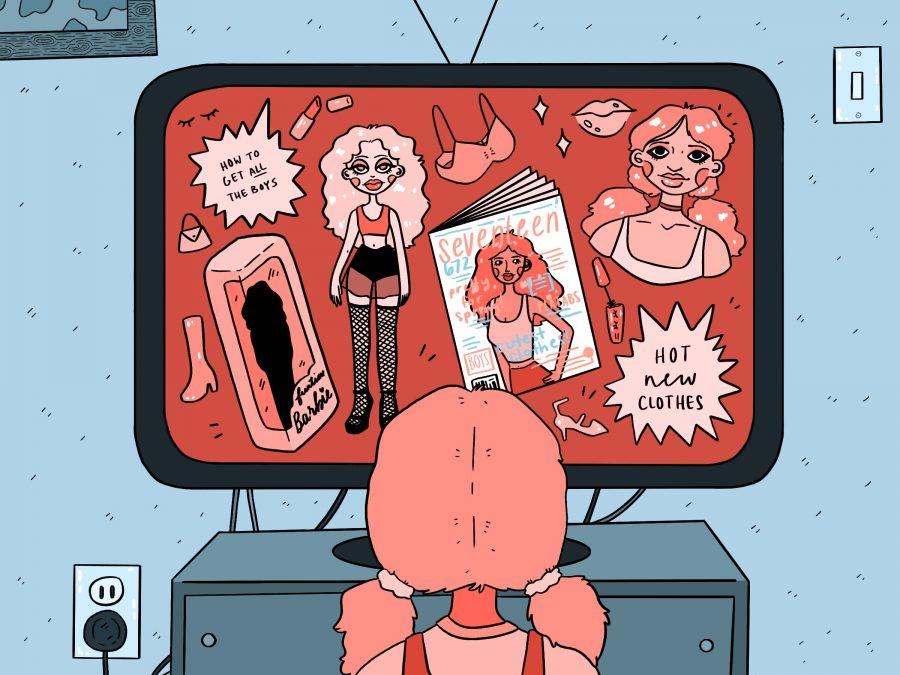As schools reopen amid the COVID-19 pandemic, 74% of the 100 largest school districts chose remote learning as their back-to-school model, leaving over nine million students to learn in isolation this year. According to a report for the Council on Contemporary Families by Christia Spear Brown, professor of psychology at the University of Kentucky, the switch to virtual learning will mean an increase in the consumption of visual media that may outweigh real-life interactions with peers.
Without adult supervision, children often cannot make informed decisions about inappropriate images because they lack the tools to accurately decipher the messages media conveys to them.
An overwhelming percentage of media that minors see presents sexualized characters, especially girls, even in shows specifically targeted toward children. These programs are also increasing in availability, and Brown’s report found at the rate elementary-aged girls were watching television, children’s programs show them approximately 80,000 examples of “sexy girl” role models in a single year.
“Although boys and girls consume the same amount of media,” Brown wrote. “That extra dose of media exposure may have very different consequences for boys and girls, slowing down ongoing progress toward gender equality.”
The difference between media’s effects on girls and boys is that content mass media exposes to girls often show female characters in revealing clothing, perpetuating the message that popularity and value are derived solely from one’s physical appearance and sex appeal.
In a 2016 study conducted by the psychological sciences program at the University of California, where researchers analyzed the ten most popular television programs among white and Latina elementary school girls in the U.S., television shows depicted female characters in sexually objectifying ways 75% of the time. To begin with, only 38% of characters in the studied shows were girls.
“This delivers a two-pronged message,” Brown wrote. “[The message that] girls are less important overall than boys, and the only way to be important – to be noticed – is to be sexy, attractive, and flirty with boys.”
These ideas are sent out to girls from a young age not just through television but through nearly all forms of media including movies, video games, magazines and music videos. A report by the American Psychological Association (APA) Task Force on the Sexualization of Girls found as girls get older, this constant exposure to the objectification of female bodies can cause girls to internalize the sexualizing messages in the cultural environment they exist in, impacting them during identity formation.
The idealized versions of women most often shown in teen girls’ and women’s magazines contribute to girls developing a more objectified view of themselves and feeling dissatisfied or insecure about their own bodies. The APA discovered the focal point of many of the articles, ads and photographs in these magazines were to advise women on topics like hairstyles, cosmetics, clothing, diet and exercise. Through the form of advice, these magazines attempt to reshape readers to better fit the societal mold as an object of male desire.
The pressure to conform to societal beauty standards from the media has caused girls to place emphasis on physical attractiveness, and with few women meeting the cultural standard for beauty, many are left feeling ashamed and even disgusted with their bodies and appearance in comparison to the unrealistic standards.
A study from Flinders University by Marika Tiggermann on the internalization of sexualized messages and body image of six to nine-year-old girls, found girls who want to wear sexy clothing or believe being sexy equates to popularity were more likely to dislike their bodies, rating their ideal body as thinner than their own. A different report from the APA shows adolescents who objectify their bodies have significantly lower self-esteem and, according to the APA, were at much higher risk of developing eating disorders or appearance-related anxiety.
Another example of sexualized media is the 2020 Netflix film, “Cuties,” which received much criticism for exploiting minors on a highly viewed streaming service with the actress of one of the main characters being only twelve years of age. This resulted in Senator Ted Cruz demanding the Department of Justice opens an investigation into Netflix’s “distribution of child pornography” on Twitter.
The movie follows eleven-year-old Amy Diop, played by fourteen-year-old Fathia Youssouf. Amy Diop pushes her household’s restrictive religious boundaries by forming a dance team with three other girls at her school that dress and dance in an overly provocative manner. As she navigates between these two antithetical worlds, the story presents breaking off from her family’s traditional views as a way for Amy to finally take charge of her sexuality. This message, depicted as a form of empowerment, perpetuates stereotypes that are just as difficult to overturn as definitions of desirability in past cultures.
Society has replaced the domesticity and modesty expected of women in the past with an equally restrictive expectation for girls to sport revealing clothes and make-up while carrying themselves in a way that seems they are constantly trying to enthrall the sexual attention of men.
Despite the dangerous effects that objectification of young bodies in the media has on girls’ development, this sexualization is a side effect of a society that strives to capitalize on sex, and the media and entertainment industry will continue using young girls as a way to generate profit. To mitigate the harms of premature sexualization, schools and families should take the matter into their own hands.
The implementation of media literacy programs in schools would provide children with the skills to view media critically and challenge the realism of what they see, training girls to become active interpreters of messages rather than passive consumers.
A study from Washington State University Vancouver found that high school girls who participated in a media literacy program were less prone to internalizing messages about body image. These initiatives were also found to be effective in increasing girls’ skepticism about authenticity and intent behind images that promoted thin ideals of beauty.
Additionally, parental mediation and co-viewing of media would allow parents to comment on what is appropriate and inappropriate, helping to control the influence of messages exhibited in video content.
Through providing alternative resources and guidance for girls in their learning, parents and teachers help girls become adept in forming healthier views on sexuality, aiding to counteract the damaging influence of what the media displays to girls.
How do you think sexualized media content affects the development of young viewers? Let us know in the comments below.















































































